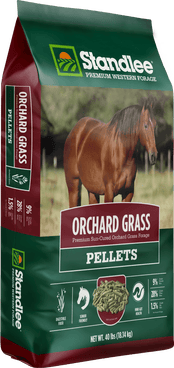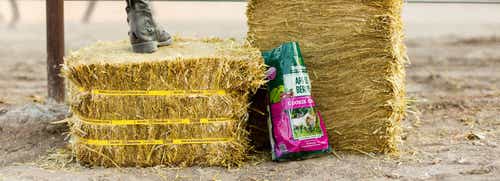
Feeding Cattle – What You Need to Know About Forage, Winter and Spring Grass Transition
Cattle are ruminant animals, meaning they have a four-compartment stomach that is designed to ferment and digest plant fiber (pasture/hay). The intricate stomach design retains fiber long enough so bacteria and other microorganisms can ferment and digest it. This fiber digestion process allows for massive fiber intake, followed by hours of regurgitating, re-chewing and re-swallowing of the partially digested fiber.
With a digestive system uniquely designed to digest fiber, cattle rely heavily on quality fiber to satisfy their nutrient requirements. Cattle are capable of a daily fiber intake of up to 3% of their body weight. With this high fiber intake, cattle can easily satisfy their calorie and protein requirements when fed high-quality fiber (pasture/hay). Add free-choice supplementation with a trace mineral salt designed for cattle, along with fresh clean water, and nutrient requirements are satisfied. Cattle are notorious for being able to consume poorer quality fiber including tall, dry, mature pasture plants. They are also capable of eating “cow hay” which is a term that describes baled hay that was cut past optimum maturity and may have weather damage from outside storage conditions. When cattle consume these poorer quality fiber sources, their voluntary intake decreases to 2 – 2.5% of body weight. Since quality of fiber and intake is reduced, the cattle will require additional energy, protein and mineral supplementation to satisfy nutrient requirements. These nutrients are typically supplied by supplementing a portion of the diet with high-quality forage, such as alfalfa, or by providing free-choice access to molasses-based lick tubs with protein and minerals added to them.
Feeding Cattle in Winter
Many areas of the country are experiencing unprecedented cold, snowy weather. One of the major concerns for feeding cattle during extreme weather conditions is keeping them warm and as comfortable as possible. The solution to keeping them warm and comfortable lies within their digestive system. Rumen bacteria are not 100% efficient when they ferment fiber; a by-product of this fermentation process is heat. The heat produced from less than 100% efficient plant fermentation helps to keep cattle warm and comfortable. Cattle can have snow on their backs and be out in cold, windy weather and be completely warm if their rumen is full of forage to ferment. So, offering high-quality, free-choice hay is the best solution. Determining which forage type to select for cattle in the winter depends on the nutrient requirements of the cattle.
Alfalfa Forage
Feeding mature cows that calved in the fall and are producing milk, or cows that are due to calve early in the spring, both have high protein and energy requirements. These cows benefit from the high protein and energy content of alfalfa forage. Similarly, if feeding yearling steers or replacement heifers that are not being supplemented with grain and protein supplements, alfalfa forage is the ideal choice to help provide nutrients for growth.
Grass Forage and Mixed Forage
Grass forages (timothy and orchard grass) or mixed (grass/alfalfa) forages are the best choice to feed to cows that are not due to calve until late in the spring. These cows have lower nutrient requirements in the winter since they are not yet in late pregnancy, when the bulk of fetal development occurs. Grass hay or mixed grass/alfalfa hay is also a great choice for growing cattle, including show cattle, that are being fed a grain concentrate fortified for growth. Finally, mature bulls are often fed the lower calorie grass hay during winter months to help control weight gain that can occur when bulls are not actively breeding.
Transitioning to Spring Grass
When spring grass finally arrives, the first reaction is to turn cattle out on pasture and quit feeding hay. Unfortunately, spring grass can contain an abundance of water and grass can be in short supply. This situation will result in cattle filling up on water without getting adequate fiber and nutrients. A solution to this issue, is to limit feeding grass hay (timothy or orchard grass) at a rate of 1% of body weight for approximately two weeks. This provides cattle with useable fiber and nutrients until the water content of the grass has decreased and the volume of grass has increased. If cattle are not supplemented with a small amount of forage during the early spring when pasture is just starting to grow, they will lose body condition and may have trouble getting pregnant. In the case of growing cattle, they may go through a period of time when they will not grow properly.
If you have questions, please contact the nutritionists at Standlee Premium Western Forage, or consult with your veterinarian.
By Dr. Stephen Duren
Standlee Nutritional Expert - Performance Horse Nutrition









